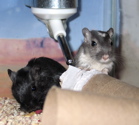![]()
 When you're ready to adopt gerbils, you'll want to make sure that you select the right pair. You'll want gerbils who are healthy, properly sexed (so you don't end up with accidental litters), and active. There are a couple of things you should consider. First, you should make an informed decision about where you'll adopt your gerbils. Second, you should know how to tell which gerbils are healthy.
When you're ready to adopt gerbils, you'll want to make sure that you select the right pair. You'll want gerbils who are healthy, properly sexed (so you don't end up with accidental litters), and active. There are a couple of things you should consider. First, you should make an informed decision about where you'll adopt your gerbils. Second, you should know how to tell which gerbils are healthy.
Where To Adopt Your Gerbils
There are basically three places from which you can adopt your gerbils. The most common place people get their gerbils is a pet shop. There are also gerbil breeders, and many shelters also have lost, abandoned, or surrendered gerbils available for adoption.
Breeder. In most cases, the safest place to get your gerbils is a breeder. A breeder should know how to tell male and female gerbils apart, even at a young age. Also, a good breeder will spend time hand-taming the gerbils from the time that they're just little pups. By the time you adopt them, they should be quite tame and used to human hands. This can be especially helpful if you're adopting your first gerbils. Also, most breeders breed gerbils just because they enjoy it and not to make a profit. It's usually cheaper to adopt from a breeder than from a pet shop.
Shelter. Another place you may want to find your gerbils is in a shelter. These gerbils are looking for a home and someone to love them. There are many common misconceptions about shelters. For example, many people think that shelter pets will be mean or sick. Usually, though, the gerbils in a shelter are as sweet as any other gerbils. You may need to spend a little bit of time building their trust, but we haven't found it to be any more work to tame a shelter gerbil than a pet shop gerbil.
Pet shop. Pet shops usually aren't the best place to adopt your gerbils. This is because many pet shops sell inbred or missexed gerbils. Of course, there are also a lot of very good pet shops, too! But remember that most pet shop employees are just part-time workers, often students. You should make sure that you know how to tell male and female gerbils apart and that you know how to tell which gerbils are healthy rather than relying on the advice of the pet shop employee.
If you'd like to adopt from a breeder or a shelter, please see the Shelters & Breeders section of our Gerbil Links page.
What A Healthy Gerbil Looks Like
 There are several things to check for when you choose your gerbils. First, make sure that they have bright, wide eyes, like the gerbils in the photo to the left. You can see that neither gerbil is squinty, and their eyes are bright and happy-looking.
There are several things to check for when you choose your gerbils. First, make sure that they have bright, wide eyes, like the gerbils in the photo to the left. You can see that neither gerbil is squinty, and their eyes are bright and happy-looking.
Make sure that none of the gerbils you adopt have wounds, especially on the rump, tail, or mouth, as these are usually signs of a fight. Likewise, if you see one gerbil bullying the others, it's a sign that there may be problems. Try to choose two gerbils who already live together and who get along well.
Don't adopt a gerbil if it or any of its tankmates have ruffled or funny-looking fur. A gerbil's coat should be shiny and sleek. When a gerbil has a rough coat, it's usually a clear sign of illness.
 Gerbils sleep together in a little pile, like the gerbils in the photo to the right. If you see a gerbil sleeping in a corner (or in the middle of the tank) by himself, he is probably sick.
Gerbils sleep together in a little pile, like the gerbils in the photo to the right. If you see a gerbil sleeping in a corner (or in the middle of the tank) by himself, he is probably sick.
 Sometimes, a gerbil's condition is even more obvious. For example, the gerbil to the left is sick. You can see just by looking at her that she doesn't feel well. She's by herself, with her eyes shut, and she's hunched over and breathing funny.
Sometimes, a gerbil's condition is even more obvious. For example, the gerbil to the left is sick. You can see just by looking at her that she doesn't feel well. She's by herself, with her eyes shut, and she's hunched over and breathing funny.
Finally, if you see a gerbil with what looks like a sore or bloody nose, you should know that he probably isn't well. Gerbil mucous is red, so a gerbil with a red nose often has a cold or allergies.
Finally, make sure that you can tell if the gerbils you adopt are males or females. The NGS (National Gerbil Society) has an excellent page that shows how to tell the difference between males and females.



